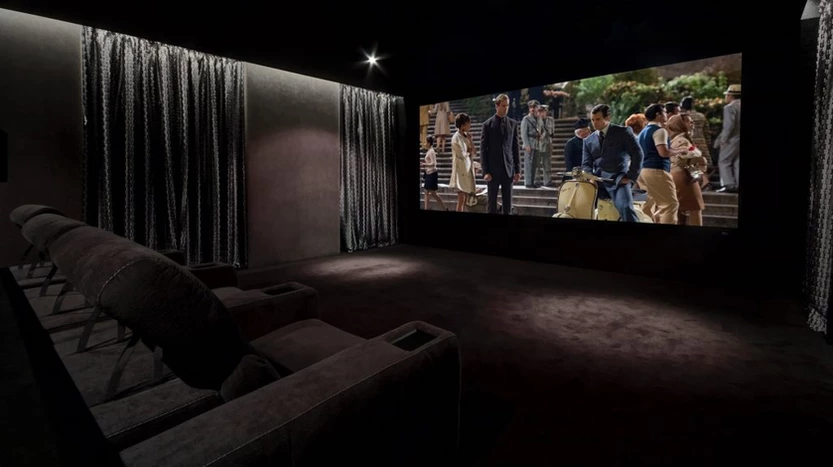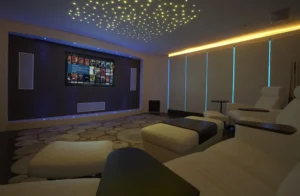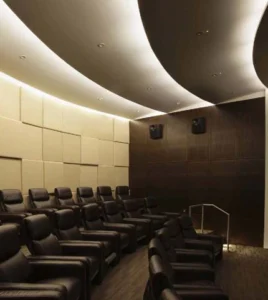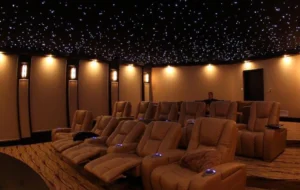Complete Guide to Cinema Room Lighting
All you need to know – from Micarta experts
Table of Contents
In one of our previous articles, we showed you plenty of cinema room ideas and shared useful tips to help you build your perfect home cinema experience, with different budgets and price points.
The only problem is that no matter how affordable they are – it’s still a considerable amount for most of us. The question is – so that’s it? Is there no way to make it happen without spending half of my savings? We believe there is a solution – a pretty good compromise if you will. It’s cinema room lighting.
As simple as it sounds, it can make all the difference in the world – it’s just one of these essential cinema room accessories. When we think about it, the skilful application of lights is the fastest way to turn a regular room into a viewing experience that can rival any actual cinema. A lot depends on your TV or a projector, of course, but even if it’s subpar, worry not – not everything is lost.

Why Cinema Light Is the Answer
We don’t really associate movie theatres with lights. It’s more about the smell of popcorn, good audio and a huge screen. After all, it would appear they don’t do much – they’re off and it’s dark (which is not strictly true). That’s all there is to it. In reality, this often overlooked, underappreciated and seemingly insignificant element plays a pivotal role.
First, let’s answer the obvious question – what’s that role? It’s immersion. The proper lighting serves the purpose of enhancing your viewing experience, making any movie more captivating so that you, as a viewer, can truly get lost in this picture painted by the director and actors, and forget about everything else.
Especially at home, it’s really easy to get distracted. Our phone is right there, maybe the film you’re watching right now is in a not-so-attention-grabbing moment… It’s easy to ruin everything, leaving us completely dissatisfied with the whole movie.
Why do you think phones are banned at professional cinemas? Sure, recording and copyright issues. What about not interfering with other people’s watching experience? Absolutely. But it also helps us focus entirely on what’s in front of our eyes. Cinema room lighting gives us all we need to replicate and imitate that. We get a similar effect and feel more immersed and invested.
The second reason is affordability. This term has been coined for quite some time, and we know it’s actually relative. Especially considering there are many lighting solutions out there that aren’t particularly wallet-friendly. That doesn’t change the fact you can easily make your movie nights much better at a fraction of the price.
Last but not least – health reasons. Contrary to popular belief, watching in a totally dark room isn’t the right way. It causes eyestrain. Doing so for a prolonged period of time can in turn lead to more serious issues. That bright contrast is quite dangerous, which is why an adequate level of lighting should be a given.
How to Get Cinema Room Lighting Effect at Home
Unlike audio solutions, cinema room lighting at home is all about convenience and working with what you already have. No need to knock down the walls or rearrange everything. So, the first thing to consider is your furniture and TV arrangement. Where’s the screen? Do I have enough space on my walls or should go for ceiling lights? These are the questions you have to answer.
But even before that – we have to look at the big picture, and that means starting with the whole room. Most likely, it’s actually a living space or even a kitchen, not a dedicated full-on home cinema haven. That’s why the lighting arrangement has to be practical above anything else.
It’s all about balance – the solution needs to be dim enough to get that cinema-like effect, but it also should be bright enough to easily navigate around the room in everyday life. Once that’s out of the way, it’s time to focus on specifics.
You certainly don’t want lights reflecting on your screen, so the opposite wall is probably not the best idea. Generally speaking, it’s better to place them on the sides, or the ceiling. Dimmable lights can take care of that little conundrum since you can completely adjust light intensity whenever you like. You’ll appreciate them even more if you have a projector. Bright lights tend to completely wash out the image.
Cinema Room Lighting
Combining different types of home cinema lighting solutions will work best in most spaces. That’s why when we’re talking about cinema room lighting, we typically mean the full installations, layers of different solutions, often referred to as techniques. Let’s talk specifics.
Ambient lighting
The most important part, the rest is pretty much optional. It’s not really a single product or a lightbulb, but an idea and combination of different solutions. That’s why it’s absolutely fundamental. Dimmable lights are a must-have for ambient lighting. Ceiling lights or cove lighting with LED strips definitely add a nice touch and enhance the experience. Just make sure your overhead lights are not placed directly under the seating area – this can ruin the overall experience. Scones, seat-side lights, star ceilings, and even floor lamps are all great options. It’s all about mixing and matching.
Task lighting
This may sound quite enigmatic, but it’s actually rather simple. The light has a specific task – illuminating a part of the room or an object (a chair, a table, a minifridge). A good and clear example of that is a regular desk lamp – it has a simple job to do, which is providing better conditions for work or reading. They tend to be less bright than traditional sources of light, so it’s really about making specific and important elements more visible or accessible.
Accent lighting
Accent lighting is primarily used to highlight or draw attention to specific objects, architectural features, or areas within a space. It is often employed to create visual interest and enhance the aesthetics of a room. Accent lighting can add depth and dimension to a space by creating highlights and shadows, making certain elements stand out. Mostly, it’s more of a stylistic addition with extra features. They’re much less bright and intense than task lights because they serve a completely different purpose.
Bias lighting
This technique was designed specifically to reduce eyestrain and improve comfort during movie-watching sessions. They’re often placed directly behind the TV, providing a gentle and soft light source. This way, it makes the contrast between the bright screen and dark surroundings less prominent, which makes eye fatigue much less of a problem.
Types of Home Cinema Lighting
Now let’s move on to the most popular elements and specific solutions. It’s quite clear “a perfect choice” doesn’t exist – it all depends on a range of different factors, from personal preference to specific requirements of the house.
Cinema wall lights

Cove lighting

Typically, they have to be installed between the architectural moulding and the ceiling. Cove lighting or indirect lighting is definitely a hit of recent years and no wonder – they provide a subtle glow without any glare.
LED strips
We mentioned them in the context of cove lighting, but there are more applications. They can be used on the floor, around the chairs, directly on the walls, or around the whole room – the choice is yours. Some models have a wide array of fun features, like changing colours, intensity, and syncing to music or sounds.
Seat-side lights
They’re stylish and above all – practical. Navigation around the dark room can be quite a challenge and a fun movie night can turn into an ER visit very quickly. So, to make sure you’re safe it might be a good idea to at least consider them. They are non-essential but still can be useful in some spaces.
Star ceiling lights

Also known as fibre optic star ceilings or starry sky ceilings, they are a hugely popular lighting feature that – you guessed it – simulates the appearance of a starry night sky on the ceiling.
They use fibre optic cables with tiny LED light sources at one end to create a mesmerizing and quite realistic effect of twinkling stars. They can add that bit of magic to your home movie theatre.
Final Considerations
All in all, there are plenty of ways to improve your very own home cinema lighting setup. Lighting is hands down the best and, more importantly, the most affordable way to do so. It’s not hard to match or even exceed the actual cinema experience with all the different types of cinema room lighting. Budget plays a key role, but even with just a few strategically placed, high-quality items, you can take your movie nights to a whole new level.
A bigger budget offers more convenience, that’s why if you’re willing to spend a little more, you might want to look into smart controls, dimmers and switches. Something similar, yet more affordable is just an app-friendly light bulb or a set of LED strips. A simple smart home installation can offer more versatility and control.
The last point of consideration we haven’t mentioned yet is the right colour temperature – the whole setup can depend on this one factor. Simply put, it’s about how cool or warm the lighting colour is. It’s measured in Kelvins, and here’s a quick guide for your reference – 2700K is soft white, and 5000K is considered a very plain white.
Most light bulbs are somewhere between 2000K-6000K. If your room is quite dark (grey or black walls) cooler lighting, like 4500K – 5000K, is the way to go. If, on the other hand, it’s much lighter or has wooden accents, it’s best to stick with something around 2500K – 3000K. Don’t forget about the lighting solution with the colour change feature – they can actually take care of that problem entirely for you.
We, at Micarta, are experts at home cinema installation. Contact us and we’ll help you find and implement the perfect solution for you and your home.
We work with various manufacturers and leading technologies, including Lutro, Rako, and more.
Contact us
The Micarta Team are based in Kent, England. We are specialists in professional integrated technologies and provide the highest quality design, installation and service to our customers.
020 3026 9931 | info@micarta.co.uk | Kent, England, United Kingdom | Monday – Friday 0800 – 1800
